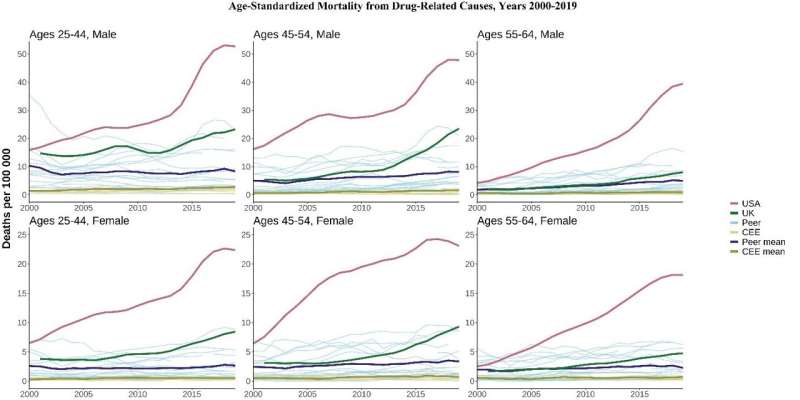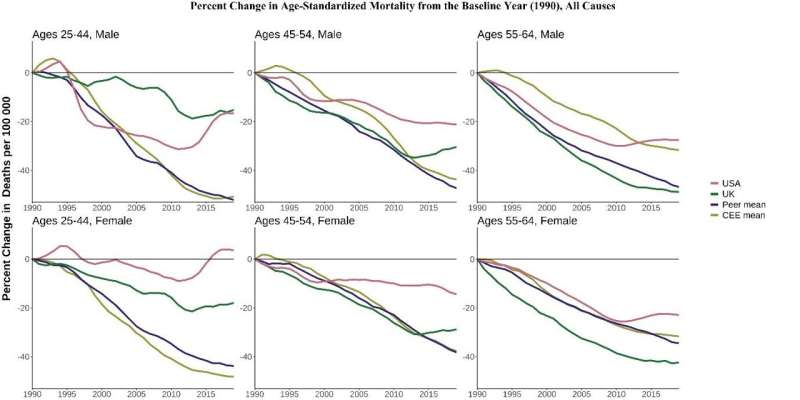This article has been reviewed according to Science X's editorial process and policies. Editors have highlighted the following attributes while ensuring the content's credibility:
fact-checked
trusted source
proofread
New study highlights troubling trends in midlife mortality in the US and UK

A new study by researchers at the Leverhulme Centre for Demographic Science (LCDS) and Princeton University reveals that US working-age adults are dying at higher rates than their peers in high-income countries; the UK is also falling behind. The study is published today in the International Journal of Epidemiology.
Using annual mortality data from the World Health Organization Mortality Database, the study compared trends in midlife mortality for adults aged 25-64 years between 1990 and 2019 across 15 major causes of death in 18 high-income countries, including the US and UK, and seven Central and Eastern European countries.
Over the past three decades, the study found that most of these countries have experienced significant declines in midlife mortality from all possible causes of death, known as all-cause mortality. US improvements, however, were slower and interrupted by recent periods of stalling and reversals, depending on age and sex. As a result, by 2019, the US saw all-cause mortality rates that were 2.5 times higher than the average of other high-income countries studied.
Worsening midlife mortality in the US was driven by several causes of death, including highly preventable ones such as transport accidents, homicide, suicide and drug overdoses. For example, drug-related deaths in the US increased up to 10-fold (depending on sex and age group combination) between 2000 and 2019, diverging tremendously from other countries.
Dr. Katarzyna Doniec, corresponding author of the study and Postdoctoral Researcher at LCDS and the Demographic Science Unit, said, "Over the past three decades midlife mortality in the US has worsened significantly compared to other high-income countries, and for the younger 25- to 44-year-old age group, in 2019 it even surpassed midlife mortality rates for Central and Eastern European countries. This is surprising, given that not so long ago some of these countries experienced high levels of working-age mortality, resulting from the post-socialist crisis of the 1990s."
The study highlights the health disadvantage of younger US females aged 25-44 years old who were the only group across the 25 countries studied to experience higher mortality rates in 2019 than in 1990.
The UK is also falling behind its high-income peers with midlife mortality increasing for people aged 45-54, and death rates among 25-54 year olds stagnating instead of improving. Midlife mortality among 25–44-year-olds also rose in Canada since 2013 alongside small increases for males of the same age range in Poland and Sweden, although these increases were far smaller than in the US.

While the UK performed relatively well on external causes of death such as suicide, homicide and traffic accidents, this was countered by stalling improvements in cardiovascular disease and cancer, and increasing drug deaths. The study also found that by 2019 younger females (25–44-year-olds) in the UK fared worse than all high-income peers, except the US, and even some of the Central and Eastern European countries.
Professor Jennifer Dowd, lead author and Deputy Director of LCDS and the Demographic Science Unit said, "Our study adds to the evidence that UK mortality is increasingly diverging from its high-income peers, especially for younger women. The causes of this worsening health will be important to understand going forward."
The study concludes that mortality declines witnessed in other high-income countries imply significant room for mortality improvement in both the US and UK. The study did not cover the years of the COVID-19 pandemic, when the life expectancy gap between the US and high-income countries widened further.
More information: Jennifer Dowd et al, US Exceptionalism? International Trends in Midlife Mortality, International Journal of Epidemiology (2024). DOI: 10.1093/ije/dyae024





















